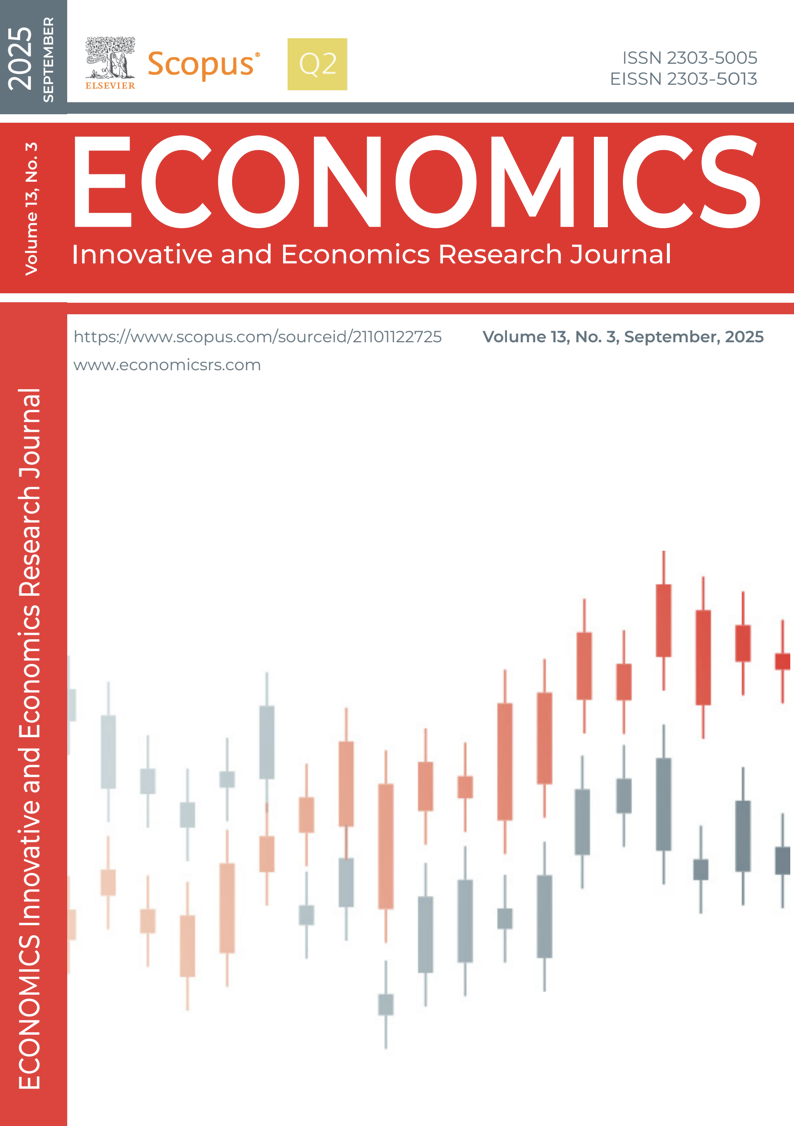FINANCIAL DEVELOPMENT, TECHNOLOGICAL INNOVATION, AND ENVIRONMENTAL DEGRADATION: EVIDENCE FROM LOWER-MIDDLE-INCOME COUNTRIES IN ASIA
DOI:
https://doi.org/10.2478/eoik-2025-0062Keywords:
Ecological footprint, environmental degradation, financial development, lower-middle-income, technology innovationAbstract
This study analyzes the causal relationship between financial develop-
ment and technological innovation, considering their impact on envi-
ronmental degradation. The data sample covers nineteen lower-mid-
dle-income countries in Asia over the period 2000-2021. By using
the panel vector autoregression (PVAR), the authors demonstrate the
close relationship between financial development and technological
innovation. Specifically, technological innovation fosters financial
development in both the short and long term, while the latter plays a
vital role in driving the former over the long term. Furthermore, finan-
cial development is reported to worsen environmental degradation in
these countries in both the short and long run. These findings imply
that while financial development provides essential financial resourc-
es for technological innovation, it may also contribute to environmen-
tal degradation by stimulating business activities, investment, and
energy consumption. Meanwhile, technological innovation promotes
financial development but has not significantly improved the ability
to mitigate environmental degradation in these countries. These find-
ings align with the characteristics of lower-middle-income countries,
where financial resources for business expansion and technological
innovation are prioritized, but measures to stop environmental deg-
radation remain limited. In light of the findings, the study provides
recommendations for governments and policymakers in these econo-
mies, emphasizing the need to promote financial development coupled
with minimizing environmental degradation, particularly by further
innovating technology to achieve substantial environmental benefits.
References
Abrigo, M. R. M., & Love, I. (2016). Estimation of Panel Vector Autoregression in Stata. The Sta-
ta Journal: Promoting Communications on Statistics and Stata, 16(3), 778–804. https://doi.
org/10.1177/1536867X1601600314
Adams, S., Klobodu, E. K. M., & Apio, A. (2018). Renewable and non-renewable energy, regime
type and economic growth. Renewable Energy, 125, 755–767. https://doi.org/10.1016/j.
renene.2018.02.135
Adebayo, T. S., Akinsola, G. D., Bekun, F. V., Osemeahon, O. S., & Sarkodie, S. A. (2021). Miti-
gating human-induced emissions in Argentina: Role of renewables, income, globalization, and
financial development. Environmental Science and Pollution Research, 28(47), 67764–67778.
https://doi.org/10.1007/s11356-021-14830-5
Aghion, P., & Howitt, P. (1992). A model of growth through creative destruction. Econometrica, 60(2),
–351. https://doi.org/10.2307/2951599
Ahmed, Z., Asghar, M. M., Malik, M. N., & Nawaz, K. (2020). Moving towards a sustainable envi-
ronment: The dynamic linkage between natural resources, human capital, urbanization, eco-
nomic growth, and ecological footprint in China. Resources Policy, 67, 101677. https://doi.
org/10.1016/j.resourpol.2020.101677
Ahmed, Z., Wang, Z., Mahmood, F., Hafeez, M., & Ali, N. (2019). Does globalization increase the
ecological footprint? Empirical evidence from Malaysia. Environmental Science and Pollution
Research, 26(18), 18565–18582. https://doi.org/10.1007/s11356-019-05224-9
Ahmed, Z., Zhang, B., & Cary, M. (2021). Linking economic globalization, economic growth, financial
development, and ecological footprint: Evidence from symmetric and asymmetric ARDL. Eco-
logical Indicators, 121, 107060. https://doi.org/10.1016/j.ecolind.2020.107060
Andrews, D. W. K., & Lu, B. (2001). Consistent model and moment selection procedures for GMM
estimation with application to dynamic panel data models. Journal of Econometrics, 101(1),
–164. https://doi.org/10.1016/S0304-4076(00)00077-4
Asongu, S. A., Le Roux, S., & Biekpe, N. (2018). Enhancing ICT for environmental sustainability in
sub-Saharan Africa. Technological Forecasting and Social Change, 127, 209–216. https://doi.
org/10.1016/j.techfore.2017.09.022
Baigorri, B., Montañés, A., & Simón-Fernández, M.-B. (2025). The influence of the great recession on
the relationship between ecological footprint, renewable energy and economic growth. Environ-
mental and Sustainability Indicators, 25, 100556. https://doi.org/10.1016/j.indic.2024.100556
Baloch, M. A., Ozturk, I., Bekun, F. V., & Khan, D. (2021). Modeling the dynamic linkage between fi-
nancial development, energy innovation, and environmental quality: Does globalization matter?
Business Strategy and the Environment, 30(1), 176–184. https://doi.org/10.1002/bse.2615
Bekun, F. V., Alola, A. A., Gyamfi, B. A., & Ampomah, A. B. (2021). The environmental aspects of
conventional and clean energy policy in sub-Saharan Africa: Is N-shaped hypothesis valid?
Environmental Science and Pollution Research, 28(47), 66695–66708. https://doi.org/10.1007/
s11356-021-14758-w
Botev, J., Égert, B., & Jawadi, F. (2019). The nonlinear relationship between economic growth and
financial development: Evidence from developing, emerging and advanced economies. Interna-
tional Economics, 160, 3–13. https://doi.org/10.1016/j.inteco.2019.06.004
Brown, J. R., Martinsson, G., & Petersen, B. C. (2012). Do financing constraints matter for R&D? Eu-
ropean Economic Review, 56(8), 1512–1529. https://doi.org/10.1016/j.euroecorev.2012.07.007
Bui, N. T., & Doan, T.-T. T. (2024). Foreign direct investment and green GDP: The thresholds of finan-
cial development for economic policies. Cogent Economics & Finance, 12(1), 2437011. https://
doi.org/10.1080/23322039.2024.2437011
Chang, S.-C. (2015). Effects of financial developments and income on energy consumption. Interna-
tional Review of Economics & Finance, 35, 28–44. https://doi.org/10.1016/j.iref.2014.08.011
Bui N. T. et al. / Economics - Innovative and Economics Research Journal, doi: 10.2478/eoik-2025-0062
Cherif, M., & Dreger, C. (2016). Institutional determinants of financial development in MENA coun-
tries. Review of Development Economics, 20(3), 670–680. https://doi.org/10.1111/rode.12192
Dam, M. M., Kaya, F., & Bekun, F. V. (2024). How does technological innovation affect the ecological
footprint? Evidence from E-7 countries in the background of the SDGs. Journal of Cleaner
Production, 443, 141020. https://doi.org/10.1016/j.jclepro.2024.141020
Danish, Baloch, M. A., Mahmood, N., & Zhang, J. W. (2019). Effect of natural resources, renewable
energy and economic development on CO2 emissions in BRICS countries. Science of The Total
Environment, 678, 632–638. https://doi.org/10.1016/j.scitotenv.2019.05.028
Destek, M. A., & Manga, M. (2021). Technological innovation, financialization, and ecological foot-
print: evidence from BEM economies. Environmental Science and Pollution Research, 28(17),
–22001. https://doi.org/10.1007/s11356-020-11845-2
Elhassan, T. (2025). Green Technology Innovation, Green Financing, and Economic Growth in G7
Countries: Implications for Environmental Sustainability. Economics - innovative and econom-
ics research journal, 13(1), 69–91. https://doi.org/10.2478/eoik-2025-0023
Ercan, H., Savranlar, B., Polat, M. A., Yıgıt, Y., & Aslan, A. (2024). The impact of technological inno-
vations on the environmental Kuznets curve: Evidence from EU-27. Environmental Science and
Pollution Research, 31(13), 19886–19903. https://doi.org/10.1007/s11356-024-32303-3
Fakher, H. A., Ahmed, Z., Acheampong, A. O., & Nathaniel, S. P. (2023). Renewable energy, nonre-
newable energy, and environmental quality nexus: An investigation of the N-shaped Environ-
mental Kuznets Curve based on six environmental indicators. Energy, 263, 125660. https://doi.
org/10.1016/j.energy.2022.125660
Fakher, H. A., Panahi, M., Emami, K., Peykarjou, K., & Zeraatkish, S. Y. (2021). Investigating marginal effect
of economic growth on environmental quality based on six environmental indicators: Does financial
development have a determinative role in strengthening or weakening this effect? Environmental
Science and Pollution Research, 28(38), 53679–53699. https://doi.org/10.1007/s11356-021-14470-9
Ganda, F. (2020). Effect of foreign direct investment, financial development, and economic growth on
environmental quality in OECD economies using panel quantile regressions. Environmental
Quality Management, 30(2), 89–118. https://doi.org/10.1002/tqem.21715
Godil, D. I., Yu, Z., Sharif, A., Usman, R., & Khan, S. A. R. (2021). Investigate the role of technology inno-
vation and renewable energy in reducing transport sector CO2 emission in China: A path toward sus-
tainable development. Sustainable Development, 29(4), 694–707. https://doi.org/10.1002/sd.2167
Grossman, G. M., & Helpman, E. (1991). Quality ladders in the theory of growth. The Review of Eco-
nomic Studies, 58(1), 43–61. https://doi.org/10.2307/2298044
Jianguo, D., Ali, K., Alnori, F., & Ullah, S. (2022). The nexus of financial development, technological
innovation, institutional quality, and environmental quality: Evidence from OECD economies.
Environmental Science and Pollution Research, 29(38), 58179–58200. https://doi.org/10.1007/
s11356-022-19763-1
Jinqiao, L., Maneengam, A., Saleem, F., & Mukarram, S. S. (2022). Investigating the role of finan-
cial development and technology innovation in climate change: Evidence from emerging seven
countries. Economic Research-Ekonomska Istraživanja, 35(1), 3940–3960. https://doi.org/10.1
/1331677X.2021.2007152
Ke, H., Yang, W., Liu, X., & Fan, F. (2020). Does innovation efficiency suppress the ecological foot-
print? Empirical evidence from 280 Chinese cities. International Journal of Environmental Re-
search and Public Health, 17(18), 6826. https://doi.org/10.3390/ijerph17186826
Khrisat, M. & Alqadi, Z. (2023). Performance Evaluation of ANN Models for Prediction. Acadlore
Transactions on AI and Machine Learning, 2(1), 13-20. https://doi.org/10.56578/ataiml020102
Kihombo, S., Ahmed, Z., Chen, S., Adebayo, T. S., & Kirikkaleli, D. (2021). Linking financial develop-
ment, economic growth, and ecological footprint: What is the role of technological innovation?
Environmental Science and Pollution Research, 28(43), 61235–61245. https://doi.org/10.1007/
s11356-021-14993-1
Financial Development, Technological Innovation, and Environmental Degradation: Evidence from Lower-Middle-
Income Countries in Asia
Koçak, E., & Şarkgüneşi, A. (2018). The impact of foreign direct investment on CO2 emissions in Tur-
key: New evidence from cointegration and bootstrap causality analysis. Environmental Science
and Pollution Research, 25(1), 790–804. https://doi.org/10.1007/s11356-017-0468-2
Koondhar, M. A., Shahbaz, M., Ozturk, I., Randhawa, A. A., & Kong, R. (2021). Revisiting the re-
lationship between carbon emission, renewable energy consumption, forestry, and agricultur-
al financial development for China. Environmental Science and Pollution Research, 28(33),
–45473. https://doi.org/10.1007/s11356-021-13606-1
Kumail, T., Ali, W., Sadiq, F., Wu, D., & Aburumman, A. (2020). Dynamic linkages between tourism,
technology and CO2 emissions in Pakistan. Anatolia, 31(3), 436–448. https://doi.org/10.1080/1
2020.1742169
Levin, A., Lin, C.-F., & James Chu, C.-S. (2002). Unit root tests in panel data: Asymptotic and finite-sample
properties. Journal of Econometrics, 108(1), 1–24. https://doi.org/10.1016/S0304-4076(01)00098-7
Li, R., Wang, Q., Liu, Y., & Jiang, R. (2021). Per-capita carbon emissions in 147 countries: The effect of
economic, energy, social, and trade structural changes. Sustainable Production and Consump-
tion, 27, 1149–1164. https://doi.org/10.1016/j.spc.2021.02.031
Ling, G., Razzaq, A., Guo, Y., Fatima, T., & Shahzad, F. (2022). Asymmetric and time-varying linkages
between carbon emissions, globalization, natural resources and financial development in Chi-
na. Environment, Development and Sustainability, 24(5), 6702–6730. https://doi.org/10.1007/
s10668-021-01724-2
Luo, R., Ullah, S., & Ali, K. (2021). Pathway towards sustainability in selected Asian countries: In-
fluence of green investment, technology innovations, and economic growth on CO2 Emission.
Sustainability, 13(22), 12873. https://doi.org/10.3390/su132212873
Mahmood, H., Alkhateeb, T. T. Y., & Furqan, M. (2020). Exports, imports, foreign direct investment
and CO2 emissions in North Africa: Spatial analysis. Energy Reports, 6, 2403–2409. https://doi.
org/10.1016/j.egyr.2020.08.038
Mensah, C. N., Long, X., Boamah, K. B., Bediako, I. A., Dauda, L., & Salman, M. (2018). The effect
of innovation on CO2 emissions of OCED countries from 1990 to 2014. Environmental Science
and Pollution Research, 25(29), 29678–29698. https://doi.org/10.1007/s11356-018-2968-0
Moraliyska, M. (2023). Measuring the Justness of the European Green Transition. Collection of papers
new economy, 1, 30-41. https://doi.org/10.61432/CPNE0101030m
Nathaniel, S. P., Murshed, M., & Bassim, M. (2021). The nexus between economic growth, energy use, in-
ternational trade and ecological footprints: The role of environmental regulations in N11 countries.
Energy, Ecology and Environment, 6(6), 496–512. https://doi.org/10.1007/s40974-020-00205-y
Ozcan, B., & Apergis, N. (2018). The impact of internet use on air pollution: Evidence from emerg-
ing countries. Environmental Science and Pollution Research, 25(5), 4174–4189. https://doi.
org/10.1007/s11356-017-0825-1
Pan, D., Chen, C., Grubb, M., & Wang, Y. (2021). Financial policy, green transition and recovery after
the COVID-19. SSRN Electronic Journal, 1–49. https://doi.org/10.2139/ssrn.3719695
Prempeh, K. B. (2023). The impact of financial development on renewable energy consumption: New in-
sights from Ghana. Future Business Journal, 9(1), 6. https://doi.org/10.1186/s43093-023-00183-7
Rafique, M. Z., Li, Y., Larik, A. R., & Monaheng, M. P. (2020). The effects of FDI, technological innovation,
and financial development on CO2 emissions: Evidence from the BRICS countries. Environmental
Science and Pollution Research, 27(19), 23899–23913. https://doi.org/10.1007/s11356-020-08715-2
Razzaq, A., An, H., & Delpachitra, S. (2021). Does technology gap increase FDI spillovers on productiv-
ity growth? Evidence from Chinese outward FDI in Belt and Road host countries. Technological
Forecasting and Social Change, 172, 121050. https://doi.org/10.1016/j.techfore.2021.121050
Romer, P. M. (1990). Endogenous technological change. Journal of Political Economy, 98(5), S71–
S102. https://www.jstor.org/stable/2937632
Bui N. T. et al. / Economics - Innovative and Economics Research Journal, doi: 10.2478/eoik-2025-0062
Rutendo Magwedere, M., & Marozva, G. (2025). Inequality and Informal Economy: The Moderating
Role of Financial Technology. Economics - innovative and economics research journal, 13(1),
–211. https://doi.org/10.2478/eoik-2025-0004
Saadaoui, H., & Chtourou, N. (2023). Do institutional quality, financial development, and econom-
ic growth improve renewable energy transition? Some evidence from Tunisia. Journal of the
Knowledge Economy, 14(3), 2927–2958. https://doi.org/10.1007/s13132-022-00999-8
Sabir, S., & Gorus, M. S. (2019). The impact of globalization on ecological footprint: Empirical evi-
dence from the South Asian countries. Environmental Science and Pollution Research, 26(32),
–33398. https://doi.org/10.1007/s11356-019-06458-3
Sadorsky, P. (2011). Financial development and energy consumption in Central and Eastern European
frontier economies. Energy Policy, 39(2), 999–1006. https://doi.org/10.1016/j.enpol.2010.11.034
Saidi, K., & Mbarek, M. Ben. (2017). The impact of income, trade, urbanization, and financial devel-
opment on CO2 emissions in 19 emerging economies. Environmental Science and Pollution
Research, 24(14), 12748–12757. https://doi.org/10.1007/s11356-016-6303-3
Saud, S., Chen, S., Haseeb, A., & Sumayya. (2020). The role of financial development and globalization in
the environment: Accounting ecological footprint indicators for selected one-belt-one-road initiative
countries. Journal of Cleaner Production, 250, 119518. https://doi.org/10.1016/j.jclepro.2019.119518
Socotar, D. L., & Gabor, M. R. (2024). The Effect of Renewable Obligations on Electricity Prices - Estimates
for the UK. Collection of papers new economy, 2. 15-29. https://doi.org/10.61432/CPNE0201015d
Shahbaz, M., Solarin, S. A., Mahmood, H., & Arouri, M. (2013). Does financial development reduce
CO2 emissions in Malaysian economy? A time series analysis. Economic Modelling, 35, 145–
https://doi.org/10.1016/j.econmod.2013.06.037
Shi, L., Li, T. T., & Meng, Y. (2024). Urban Ecological Compensation Through Water Resource Eco-
logical Footprint. Opportunities and Challenges in Sustainability, 3(3), 158-167. https://doi.
org/10.56578/ocs030302
Shoaib, H. M., Rafique, M. Z., Nadeem, A. M., & Huang, S. (2020). Impact of financial development
on CO2 emissions: A comparative analysis of developing countries (D8) and developed coun-
tries (G8). Environmental Science and Pollution Research, 27(11), 12461–12475. https://doi.
org/10.1007/s11356-019-06680-z
Solarin, S. A., Nathaniel, S. P., Bekun, F. V., Okunola, A. M., & Alhassan, A. (2021). Towards achieving
environmental sustainability: Environmental quality versus economic growth in a developing
economy on ecological footprint via dynamic simulations of ARDL. Environmental Science and
Pollution Research, 28(14), 17942–17959. https://doi.org/10.1007/s11356-020-11637-8
Tamazian, A., & Rao, B. B. (2010). Do economic, financial and institutional developments matter for
environmental degradation? Evidence from transitional economies. Energy Economics, 32(1),
–145. https://doi.org/10.1016/j.eneco.2009.04.004
Tang, C. F., & Tan, B. W. (2015). The impact of energy consumption, income and foreign direct invest-
ment on carbon dioxide emissions in Vietnam. Energy, 79, 447–454. https://doi.org/10.1016/j.
energy.2014.11.033
Uddin, G. A., Salahuddin, M., Alam, K., & Gow, J. (2017). Ecological footprint and real income: Pan-
el data evidence from the 27 highest emitting countries. Ecological Indicators, 77, 166–175.
https://doi.org/10.1016/j.ecolind.2017.01.003
Ullah, S., Adebayo, T. S., Irfan, M., & Abbas, S. (2023). Environmental quality and energy transition
prospects for G-7 economies: The prominence of environment-related ICT innovations, finan-
cial and human development. Journal of Environmental Management, 342, 118120. https://doi.
org/10.1016/j.jenvman.2023.118120
Usman, M., & Hammar, N. (2021). Dynamic relationship between technological innovations, financial
development, renewable energy, and ecological footprint: Fresh insights based on the STIRPAT
model for Asia Pacific Economic Cooperation countries. Environmental Science and Pollution
Research, 28(12), 15519–15536. https://doi.org/10.1007/s11356-020-11640-z
Financial Development, Technological Innovation, and Environmental Degradation: Evidence from Lower-Middle-
Income Countries in Asia
Wang, D., Yu, W. Y., Ouyang, R. K., & Meng, Q. T. (2024). Unveiling the Mechanisms and Spatial
Spillovers of Digital Finance in Enhancing Urban Green Efficiency. Journal of Organizations,
Technology and Entrepreneurship, 2(4), 221-236. https://doi.org/10.56578/jote020403
Wijethunga, A. W. G. C., Rahman, M. M., & Dayaratne, D. A. I. (2023). The effect of financial devel-
opment on environmental quality: A developing country evidence. Environmental Science and
Pollution Research, 30(58), 121239–121252. https://doi.org/10.1007/s11356-023-30844-7
Xu, Z., Baloch, M. A., Danish, Meng, F., Zhang, J., & Mahmood, Z. (2018). Nexus between financial de-
velopment and CO2 emissions in Saudi Arabia: Analyzing the role of globalization. Environmental
Science and Pollution Research, 25(28), 28378–28390. https://doi.org/10.1007/s11356-018-2876-3
Yuxiang, K., & Chen, Z. (2011). Financial development and environmental performance: Evidence
from China. Environment and Development Economics, 16(1), 93–111. https://doi.org/10.1017/
S1355770X10000422
Zameer, H., Wang, Y., & Yasmeen, H. (2019). Transformation of firm innovation activities into brand effect.
Marketing Intelligence & Planning, 37(2), 226–240. https://doi.org/10.1108/MIP-05-2018-0176
Zameer, H., Yasmeen, H., Zafar, M. W., Waheed, A., & Sinha, A. (2020). Analyzing the association
between innovation, economic growth, and environment: Divulging the importance of FDI and
trade openness in India. Environmental Science and Pollution Research, 27(23), 29539–29553.
https://doi.org/10.1007/s11356-020-09112-5
Zhang, C., & Liu, C. (2015). The impact of ICT industry on CO2 emissions: A regional analysis in China.
Renewable and Sustainable Energy Reviews, 44, 12–19. https://doi.org/10.1016/j.rser.2014.12.011
Zhou, X., Wang, L., & Du, J. (2021). Institutional environment and green economic growth in China.
Complexity, 2021(1), 6646255. https://doi.org/10.1155/2021/6646255
Downloads
Published
How to Cite
Issue
Section
License
Copyright (c) 2025 ECONOMICS - INNOVATIVE AND ECONOMICS RESEARCH JOURNAL

This work is licensed under a Creative Commons Attribution-NonCommercial-NoDerivatives 4.0 International License.























